When Row Zero's founder, Breck, told me he and his wife were having a boy, we had the following exchange:
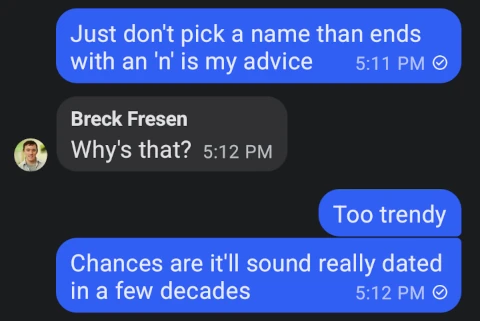
At the time, I was basing this judgment on my subjective impression that a large number of rhyming baby boy names had been very trendy in the 21st century: the Aiden Hayden Brayden Zayden Kayden Jayden brigade, who for the purposes of this post I will refer to collectively as "the -aydens" (even though I mean this to include spellings like -aiden and -aden). I didn't have the data to back this up when I said it. It was just a belief I had.
Now I have the data.
Social Security Administration Baby Name Data
Every year, the Social Security Administration (SSA) publishes nearly-comprehensive data on baby name popularity. It's not entirely comprehensive, because they exclude names that are used for fewer than 5 babies in a given year. But it gives you a good picture of the relative popularity of names over time, by sex, in the United States. You can download each year's data from the SSA's website as a csv file.
If you concatenate all those csvs together into one big data set, it's 2,085,158 rows of data. (At the time I'm writing, SSA has published data for the years 1880–2022.) That's too big for Excel, but no problem for Row Zero. In fact, when I joined the development team one of the first things I did was share this data set; it's now one of several different test data sets we use here. It's fun data to play with, and you can get your own copy of it with one click: open the SSA baby name dataset.
In this post, we're going to use that data to validate the hypothesis that the -n names, and in particular the -aydens, have been especially trendy in the 21st century.
- Boy names by final letter over time
- Girl names by final letter over time
- Does the popularity of the -aydens explain peak -n?
- Just how trendy are -ayden names?
- Conclusion
Boy names by final letter over time
We've done several cool analyses of this data in the process of testing out our pivot and charting capabilities. My favorite is one that my colleague Grant did: he graphed the popularity of baby names over time by final letter. And wow, did that ever confirm my biases!
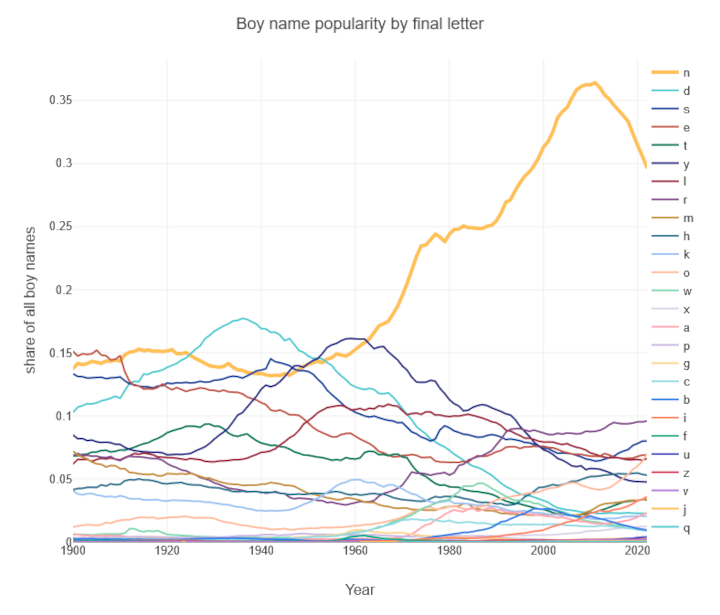
The data shows that N has been the most popular final letter for boy names in the U.S. since 1963. Back then, John was near its peak popularity, and Kevin, Steven, and Brian were all in the top 20 most popular boy names. 16% of all boy names ended with N.
But my perception of recent trendiness wasn't just an illusion: 2011 was peak -n. In that year, fully 36.4% of all baby boys in the dataset were given a name ending in N. More than 1-in-3. It's declined somewhat since then, but as of 2022 was still as high as 29.7% — heights first achieved in 1998.
Girl names by final letter over time
It might be interesting to note that -n names for boys are actually less popular than -a names for girls. But while they're less popular, they're trendier. For girls, -a names have been in the 33–40% range consistently since 1947. That might explain why they stand out less (to me, anyway), although it's not surprising that they're so popular if I think about it.
We can also see that there was a shift from -e names being most popular for girls to -a names in the 20th century, with the crossover point in 1935. I wonder whether -a names were more noticeable in the middle part of the century.
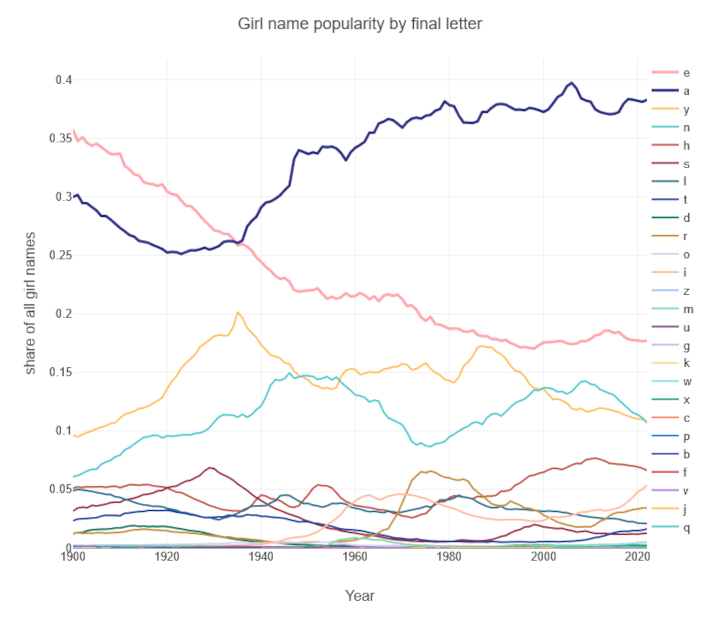
Does the popularity of the -aydens explain peak -n?
There are a lot of names that end in -n, though, so we need to do more work to confirm my superficial impression that it's the -aydens driving us to peak -n in 2011. So let's break down -n names further, by the final two letters (I've excluded some letter combinations that are attested in the data set, but only rarely).
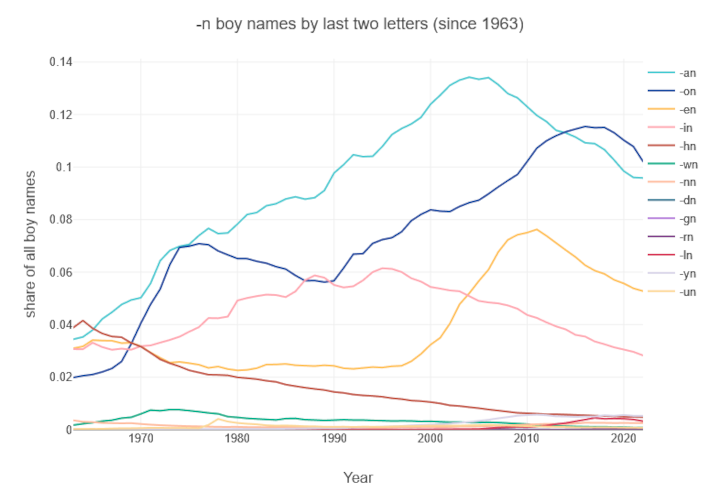
We can see that the most popular -n names are -an names — your Nathans, Ethans, Ryans, Jordans, Dylans, etc. And these names account for a lot of the initial rise of -n in the latter half of the 20th century. Kevin, Austin, Justin, Benjamin, and other -ins were quite popular for Millenials, too, boosting -n further. But -an and -in both began to decline prior to peak -n in 2011.
So it's -en and -on that pushed us to peak -n even while -an and -in were falling off. While -on makes up a larger overall share of boy names in recent years, its upward trend is more gradual than -ens, and it started from a higher baseline in the last three decades of the 20th century. Notably, our peak -n year exactly corresponds to the peak -en year, as well. Between 1997 and 2011, the share of baby boy names ending in -en rose from 2.4% to 7.6%. That's a steep ascent. Without it, -n would still be on top, but with a less pronounced peak occuring somewhat earlier.
We can easily visualize that just by filtering out the -en names from our popularity-by-final-letter time series.
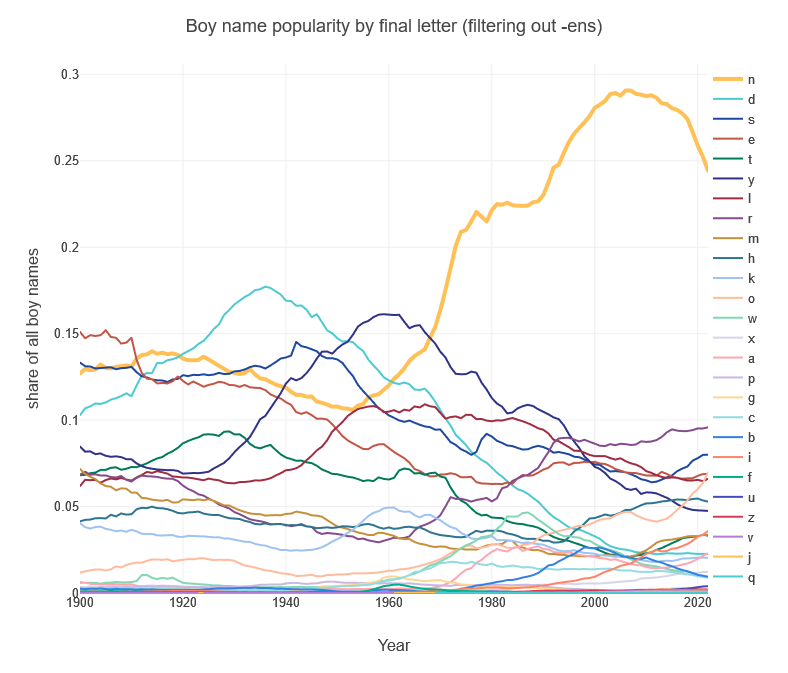
Without the -ens, peak -n occurs in 2006 at only 29%.
Of course, the -en names include recently popular names like Owen, which is notably not one of the -aydens. So let's look at how many of those -en names are the -aydens.
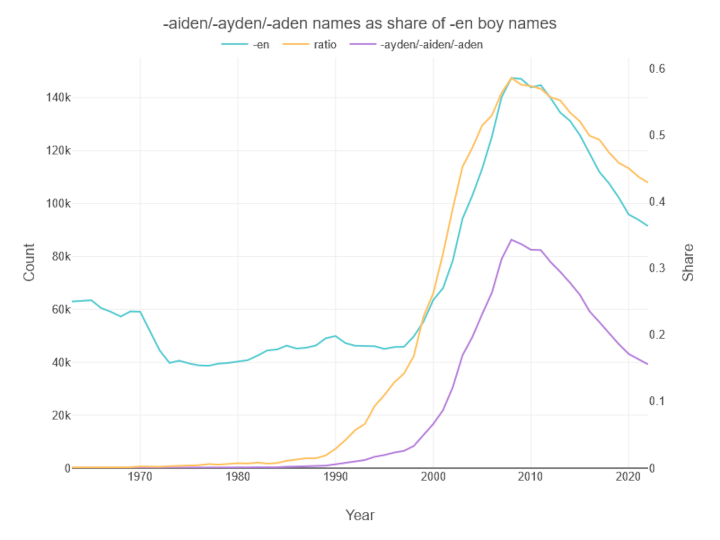
The graph above makes it clear that most of of the sudden rise in popularity of -en names for boys is explained by the -aydens. The -aydens made up 14.2% of -en boy names in 1997, and 58.6% in 2008, falling only to 56.9% in the peak -n year of 2011. In terms of raw counts, 2011 had 98,894 more -ens than 1997. It had 75,913 more -aydens. The -aydens make up 76.8% of the increase.
And we can see that the -aydens have begun to fall off, both in terms of raw counts and as a share of -en names since precisely 2011 (ok, peak -ayden was technically 2008, but the decline really accelerates in 2012 and beyond). We can conclude that, while other -n names of course contribute to -n's mountainous popularity, it's the sudden rise of the -aydens that made the final push to the summit.
Just how trendy are -ayden names?
As Pew Research defines it, Gen Z includes people born from 1997–2012 — almost exactly the span of time during which we witnessed the steep ascent of the -aydens. So just how many Zoomer baby boys got one of these names?
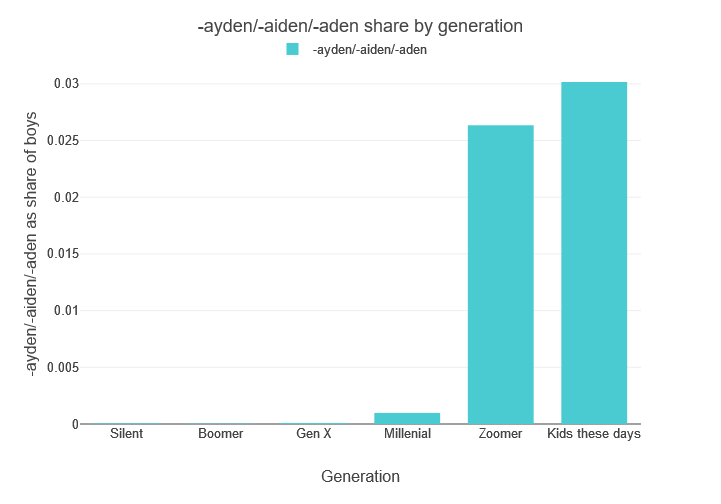
Only 0.09% of Millenial baby boys were -aydens. 2.6% of Gen Z baby boys were.
The most recent generation (whatever it ends up being called) has an even higher proportion of -aydens than Gen Z. That generation is still being born, and we've seen that the -aydens are falling in popularity, so we should expect their share to decline. But unless the -aydens fall all the way to their pre-Zoomer levels, and fast, I predict that the current generation will will be the most -ayden-ful of all time. It seems very likely that having an -ayden name will mark you as having been born in the first decades of the 21st century in much the same way that the name Heather indicates you were born in the 1970s or 80s.
Another interesting perspective on this is to compare the -aydens to the most popular names from past generations. It's well known that names in general are becoming more diverse over time in the U.S. That is to say, the most popular names in recent years are less popular, relative to other names, than the most popular names of the past. For example, Mary was, for many years in the early 20th century, the most popular girl's name. In 1921, 6% of all baby girls were named Mary. In 2000, the most popular girl's name was Emily, but only 1.43% of baby girls born that year were given that name.
In 2022, the most recent year for which we have data, the most popular boy name is Liam, with a total share of 1.2% of all baby boys born in the U.S. Collectively, the -aydens are more than twice as popular than that in the last generation and the current one. The chance that a classroom of Zoomers has two -aydens in it is a little bit higher than the chance that a Millenial classroom had two Matthews. You have to look a little bit harder to see the trends in how we name our children today. But they're still there.
Conclusion
I was actually quite surprised to find that my hypothesis is largely correct. I thought it would be a combination of the recency illusion and the frequency illusion — that I noticed these names more after I first became aware of them, and this led me to the false belief that they had only suddenly become popular. It turns out my name sense is keener than that, I guess!
I personally find the SSA data set in Row Zero both useful and fun. Useful, for picking names in the sweet spot of "not too unique, but not too popular either" — it's too easy to misjudge if you don't actually look at the data. Fun, because once you have all the data in a spreadsheet, you can answer questions you never would have thought to ask, like whether there are trends in name popularity by final letter.
It was hard to get the data in a spreadsheet for easy analysis before (it's too big!). But now you can. Row Zero makes it easy. Here you go: open the SSA baby name dataset.